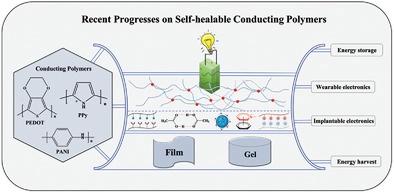当前位置:
X-MOL 学术
›
Adv. Mater.
›
论文详情
Our official English website, www.x-mol.net, welcomes your
feedback! (Note: you will need to create a separate account there.)
Recent Progress on Self-Healable Conducting Polymers
Advanced Materials ( IF 27.4 ) Pub Date : 2022-01-19 , DOI: 10.1002/adma.202108932 Yang Li 1 , Xin Zhou 1 , Biporjoy Sarkar 1 , Noémy Gagnon-Lafrenais 1 , Fabio Cicoira 1
Advanced Materials ( IF 27.4 ) Pub Date : 2022-01-19 , DOI: 10.1002/adma.202108932 Yang Li 1 , Xin Zhou 1 , Biporjoy Sarkar 1 , Noémy Gagnon-Lafrenais 1 , Fabio Cicoira 1
Affiliation

|
Materials able to regenerate after damage have been the object of investigation since the ancient times. For instance, self-healing concretes, able to resist earthquakes, aging, weather, and seawater have been known since the times of ancient Rome and are still the object of research. During the last decade, there has been an increasing interest in self-healing electronic materials, for applications in electronic skin (E-skin) for health monitoring, wearable and stretchable sensors, actuators, transistors, energy harvesting, and storage devices. Self-healing materials based on conducting polymers are particularly attractive due to their tunable high conductivity, good stability, intrinsic flexibility, excellent processability and biocompatibility. Here recent developments are reviewed in the field of self-healing electronic materials based on conducting polymers, such as poly 3,4-ethylenedioxythiophene (PEDOT), polypyrrole (PPy), and polyaniline (PANI). The different types of healing, the strategies adopted to optimize electrical and mechanical properties, and the various possible healing mechanisms are introduced. Finally, the main challenges and perspectives in the field are discussed.
中文翻译:

自愈导电聚合物的最新进展
破坏后能够再生的材料自古以来就是研究的对象。例如,能够抵抗地震、老化、天气和海水的自愈混凝土自古罗马时代就已为人所知,并且仍然是研究的对象。在过去的十年中,人们对自我修复电子材料的兴趣日益浓厚,在电子皮肤 (E-skin) 中用于健康监测、可穿戴和可拉伸传感器、致动器、晶体管、能量收集和存储设备。基于导电聚合物的自修复材料因其可调节的高导电性、良好的稳定性、固有的柔韧性、优异的加工性能和生物相容性而特别有吸引力。本文回顾了基于导电聚合物的自愈电子材料领域的最新进展,如聚 3,4-乙烯二氧噻吩 (PEDOT)、聚吡咯 (PPy) 和聚苯胺 (PANI)。介绍了不同类型的愈合、优化电气和机械性能所采用的策略以及各种可能的愈合机制。最后,讨论了该领域的主要挑战和前景。
更新日期:2022-01-19
中文翻译:

自愈导电聚合物的最新进展
破坏后能够再生的材料自古以来就是研究的对象。例如,能够抵抗地震、老化、天气和海水的自愈混凝土自古罗马时代就已为人所知,并且仍然是研究的对象。在过去的十年中,人们对自我修复电子材料的兴趣日益浓厚,在电子皮肤 (E-skin) 中用于健康监测、可穿戴和可拉伸传感器、致动器、晶体管、能量收集和存储设备。基于导电聚合物的自修复材料因其可调节的高导电性、良好的稳定性、固有的柔韧性、优异的加工性能和生物相容性而特别有吸引力。本文回顾了基于导电聚合物的自愈电子材料领域的最新进展,如聚 3,4-乙烯二氧噻吩 (PEDOT)、聚吡咯 (PPy) 和聚苯胺 (PANI)。介绍了不同类型的愈合、优化电气和机械性能所采用的策略以及各种可能的愈合机制。最后,讨论了该领域的主要挑战和前景。











































 京公网安备 11010802027423号
京公网安备 11010802027423号